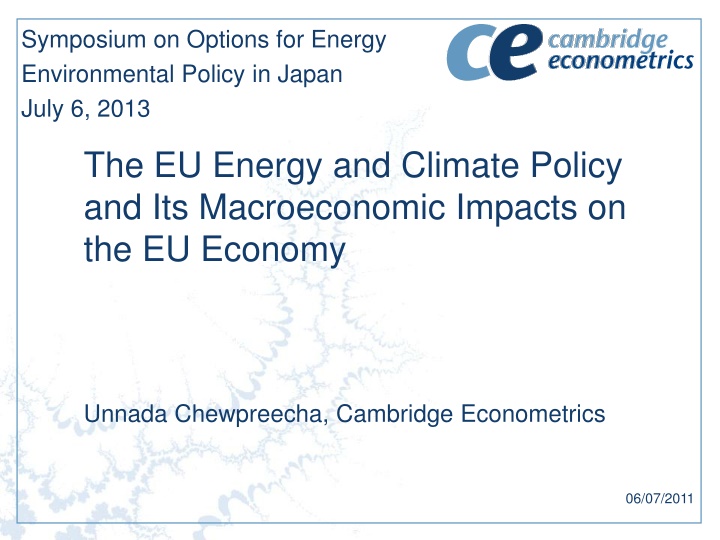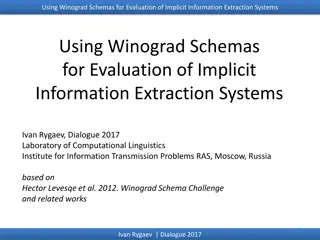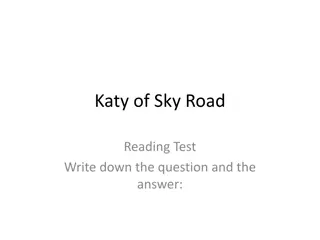
EU Energy and Climate Policy - Macroeconomic Implications & Policy Considerations
Explore the EU Energy and Climate Policy's macroeconomic impacts and complexities, including interactions with other EU targets and policies. Understand the challenges and potential solutions for achieving the 20-20-20 targets while maintaining competitiveness and sustainability.
Download Presentation

Please find below an Image/Link to download the presentation.
The content on the website is provided AS IS for your information and personal use only. It may not be sold, licensed, or shared on other websites without obtaining consent from the author. If you encounter any issues during the download, it is possible that the publisher has removed the file from their server.
You are allowed to download the files provided on this website for personal or commercial use, subject to the condition that they are used lawfully. All files are the property of their respective owners.
The content on the website is provided AS IS for your information and personal use only. It may not be sold, licensed, or shared on other websites without obtaining consent from the author.
E N D
Presentation Transcript
Symposium on Options for Energy Environmental Policy in Japan July 6, 2013 The EU Energy and Climate Policy and Its Macroeconomic Impacts on the EU Economy Unnada Chewpreecha, Cambridge Econometrics 06/07/2011
Disclaimer This presentation does not necessarily represent the views of the European Commission (EC) or any collaborating institution
Overview The EU Energy and Climate policy Assessing macroeconomic impacts using E3ME and E3MG Headline results
Overview The EU Energy and Climate policy Assessing macroeconomic impacts using E3ME and E3MG Headline results
The EU Energy and Climate Policy Headline 20-20-20 energy and climate change targets for 2020 20% cut in GHG emissions (from 1990 levels) 20% improvement in energy efficiency (from 2005) 20% share of renewable energy
The EU Climate and Energy Package A set of binding legislation which aims to ensure the 20-20-20 targets are met Effort sharing at national level EU ETS RES targets at national level CCS framework Separate Energy Efficiency Plan and the Energy Efficiency Directive
Complexity and Interaction with Other EU Targets and Policies The 20-20-20 targets are overlapped e.g. RES target could undermined the EU-ETS But one target alone will not necessary lead to other targets being met market failure e.g. pricing mechanism alone may not lead to RES and or energy-efficiency targets being met Complexity in designing national targets to achieve one single EU target Other factors undermining EU-ETS recent economic crisis EU ETS allowance prices collapse, structural reform of ETS no incentive for industries to invest in low carbon technologies
Complexity and Interaction with Other EU Targets and Policies Link to other EU 2020 Targets such as employment and R&D and other EU policies such as resource efficiencies need careful policy considerations to avoid contradictions examples: increase in biocrops leads to higher food price material tax increase costs of investment goods EU ETS and competitiveness negative impacts can be avoided/mitigated through measures such as Environmental Tax Reform (ETR)
Examples of Energy and Climate Policies in the EU key TVs MBI (+labeling) Regulation 2009/642/EC Circulators Regulation 2009/641/EC Regulations Electric motors Regulation 2009/640/EC Freezers/ refrigerators (+labeling) Regulation 2009/643/EC GHG Effort Sharing Decision 2009/406/EC* EU-ETS RES directive 2009/28/EC (Transport)) Recast of the EPBD 2010/31/EU9 Regulation Euro VI for heavy duty vehicles 2009/595/EC RES directive 2009/28/EC (Power Generation) Labelling regulation for tyres 2009/1222/E C GHG Effort Sharing Decision 2009/406/EC*
EU Policies Beyond 2020 2030 framework and 2050 roadmap Continue the momentum of 2020 targets and taking account of long-term climate goal (2 C degree) Build on the experience of, and lessons learnt from, the 2020 framework and identify where improvements can be made.
EU Policies Beyond 2020 GHG Reduction (%) Compared to 1990 -100 -80 -60 -40 -20 0 20 40 Total Power (CO2) Industry (CO2) 2005 2030 Transport (incl. CO2 aviation, excl. maritime) 2050 Residential and services (CO2) Agriculture (Non-CO2) Other Non-CO2 emissions source(s): 2050 Roadmap, DG Climate Action, European Commission
Overview The EU Energy and Climate policy Assessing macroeconomic impacts using E3ME and E3MG Headline results
Assessing Macroeconomic Impacts using E3ME and E3MG E3ME (Europe) and E3MG (world) models are: computer-based econometric models covering economy, energy and emissions with detailed sectors (linked by IO tables) and regions (Japan) and endogenous technological progress They can be used for forecasting but are typically used for policy analysis They are versatile tools that can be used for economic and economy/environment analysis They have often been used to support the official European Commission policy impact assessments
Modelling Structure E3 Model ECONOMY as in national accounts e.g. industrial emissions of SF6 funding R&D pollution- abatement equipment prices and activity TECHNOLOGY specifications & costs investment fuel use fuel use fuel prices and costs ENVIRONMENTAL EMISSIONS as in environmental statistics ENERGY as in energy statistics fuel use
How Energy and Environment Taxes are Modelled in E3ME/E3MG Increase in energy prices Reduction in energy consumption Reduction in emissions Households Industry Loss of real income Loss of competitiveness Loss of jobs Worsening trade balance Lower spending Loss of output
Studies Using E3ME/E3MG Topics E3ME/E3MG was used to.. EU ETS assess the economic impacts of different mechanisms for allocating ETS allowances The Energy Taxation Directive model the Europe-wide economic and environmental impacts of different energy taxation regimes Environmental Tax Reform provide European economic and environmental impacts of different ETR regimes, Energy Efficiency provide input to the proposed Energy Efficiency Directive by providing a quantitative assessment of the measures proposed to reduce energy demand. Moving Beyond 20% provide input for DG CLIMA s communication on changing the 2020 GHG target to 30% by assessing the economic impacts of a 30% target Green Jobs model labour market implications of the EU climate and energy policies Copenhagen targets analyse global economic impacts of the agreed Copenhagen targets
Studies Using E3ME/E3MG (cont) Topics E3ME/E3MG was used to.. Non-CO2 trading scheme assessing the impacts of introducing an EU SO2/NOx trading scheme Resource efficiency model EU resource efficiency policies through the E3ME material sub- model which covers physical resources such as food, feed, wood, metals, minerals, Carbon leakage examine the extend of carbon leakage for EU industries as a result of EU climate policies REDD provide an assessment of the two-way linkages between REDD and global carbon markets. E3MG was expanded to incorporate marginal abatement cost curves specific to the forestry sector Global 2c scenario investigate global economic implications of reaching the 2c target in 2050 Environmental harmful subsidies investigate the implications of removing environmental harmful subsidies in the EU other non-environmental applications carry out analysis on trade, labour market, sector study, R&D and investment multipliers, commodity prices and government policies
Overview The EU Energy and Climate policy Assessing macroeconomic impacts using E3ME and E3MG Headline results
Headline Results Results taken from CE work done for DG Employment Studies on Sustainability Issues Green Jobs; Trade and Labour , 2011 E3ME was used to estimate macroeconomic and labour market impacts of the EU energy and climate policies
Scenarios Summary Reference case where 20% renewables and GHG targets are met through mixture of MBIs and regulations Two scenarios where target is met differently Two scenarios with additional targets (30% GHG and 20% energy efficiency target) Revenues from MBIs recycled via income tax
Headline Results: Impacts on GDP EU27 GDP % difference from baseline Ref + Energy efficiency target is also met 0.5% S6 0.4% Ref: 20% Renewable + GHG targets met (mix MBIs & regulations) 0.3% Ref: through MBIs Ref+ 30% GHG targets met (mix MBIs & regulations) 0.2% S4 0.1% 0.0% S5 2005 2010 2015 2020 2025 ref -0.1% Ref: through regulations S3 -0.2% Source(s): E3ME, Cambridge Econometrics.
Results Summary Positive GDP and employment results are driven by investment in renewables MBIs generate revenues to be recycled while regulations increase costs but no revenues Large amount of investment requires to meet energy efficiency target (IEA 2010 estimates for every 1% reduction in energy consumption, the EU buildings sector must invest 31.4bn a year)
Revenue Recycling and Investment Increase in energy prices Reduction in energy consumption Reduction in emissions Households Industry Revenue recycling: lower income tax Investment Loss of real income Loss of competitiveness Loss of jobs Worsening trade balance Lower spending Loss of output
Sensitivity: Revenue Recycling Different Revenue Recycling Methods % difference from baseline 1.0 0.8 0.6 0.4 GDP Employment 0.2 0.0 -0.2 S4 income tax 1/4 1/4 1/4 1/4 all social benfits Employers social security Transport 3/4 income tax machinery 3/4 income tax renewables 3/4 income tax Buildings 3/4 income tax investment
Important Notes E3ME/E3MG modelling results form part of wider impact assessments Complement other analysis such as other model types (CGEs) quantitative analysis (e.g. CBA, input-output) qualitative study, literature reviews sector specific studies survey and consultations All above need to be taken into account when carry out an impact assessment
Overview- Summary The EU Energy and Climate policy 20-20-20 targets and beyond issues and complexities Assessing macroeconomic impacts using E3ME and E3MG overview of the models model applications Headline results macroeconomic impacts from EU energy and environmental policies implications of various revenue recycling methods
Thank you for your attention! The DG CLIMA web pages contain further information, including the full EC communication http://ec.europa.eu/clima/policies/brief/eu/index_en.htm For full E3ME and E3MG projects and published papers as well as the model manual www.e3me.com www.e3mgmodel.com For further information on the modelling: Unnada Chewpreecha, uc@camecon.com or Hector Pollitt, hp@camecon.com






